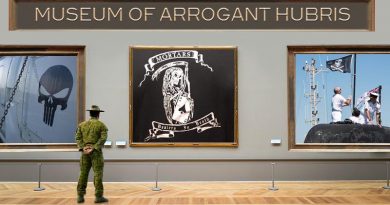Top Priority: Tank Regiment or a Combat Experimentation Group (CXG)?
Share the post "Top Priority: Tank Regiment or a Combat Experimentation Group (CXG)?"

Let’s look at 1st Armoured Regiment from the viewpoint of someone presently serving in the unit…
“If you have been keeping track of the war in Ukraine, I am sure you would have noticed the amount of ground being won by either side has slowed considerably. Degrading to mostly static trench warfare.
One of the major causes of this has been the prevalence of UASs [unmanned aerial systems] in the battlespace, with many sources stating that 80% of all casualties in the Ukraine are caused by drones.
Due to the sheer number of drones in flight, both sides are under almost constant observation, therefore it is almost impossible to force concentrate for large-scale offensive operations.
As such, a large, highly trained, expensive armoured battlegroup can be made ineffective by a disproportionately small group of individuals using comparatively very cheap equipment.
Tanks will never be obsolete, however until we find ways to combat these new threats, we won’t be able to effectively do our job as armoured crewmen.
Without ways to counter the new threats we face, a large armoured battlegroup is just a large target.”
The author, undoubtedly a supporter of the unit’s new CXG role, makes some good points. The employment of drones in Ukraine has certainly been a ‘game changer’ in terms of that conflict; particularly from the viewpoint of visibility on the battlefield.
But does that justify the tanks being stripped from 1 Armd Regt and the unit being made a non-combatant? Surely not! Someone taking a different view of the situation, might propose that:
‘It’s essential that efforts are made, as a matter of urgency, to counter the advantage that drones afford the enemy in terms of battlefield visibility. To this end, the RAAC will be tasked (as part of its training) to develop appropriate tactical concepts, including examining advances in AFV concealment (by day and night), as well as Active Protection Systems (APS), such as ‘Trophy’.’
An approach of this sort would build upon the combat power of the RAAC; rather than take away from it as the Chief of Army has done.
The role of the RAAC is to “locate, identify, capture and destroy the enemy, by day or night, in combination with other arms, using fire and manoeuvre”. The Corps used to undertake this task with three battlegroup headquarters, each with three squadrons. Now, while the role remains the same, combat power has been reduced to two battlegroup headquarters and seven squadrons.
Of course, the goal of Defence was to make savings in operating costs; and this has been achieved. But at what cost in terms of Army readiness? A complete tank regiment has lost all tank-craft and skills built up over decades of training. The Army’s sole armoured brigade is forced to operate without two squadrons and a battlegroup headquarters. One has to wonder what training deficiencies will result from these shortcomings?
Of course, the cost that the RAAC must bear in overall terms is almost incalculable. The loss of a battlegroup headquarters alone, has immense costs in terms of loss of operational experience and career prospects.
The impact in human terms was previously described in this way…
“We now come to those who feel the consequences of the CA’s decision to strip 1 Armd Regt of its tanks and make it a non-combatant – the most! How do you describe the emotional impact of the heritage and traditions built up over 75 years by a unit’s former members, being scrapped, as they’re forced to stand-by and watch?
There is a timeless bonding that few can adequately describe; camaraderie and comradeship, together with affinity and rapport. Generations drawn together by the same unifying spirit. There is an inseparability between the experiences of the past and the esprit-de-corps that existed at the time; one that doesn’t diminish. A true brotherhood from Churchill to Centurion to Leopard to M1A1 to M1A2.”
The Chief of Army is always going to get what the Chief of Army wants (or is forced to accept). What a pity it is that unit heritage and tradition count for nought as far as the drive for cost savings are concerned. What a pity it is that decisions had to be made in secret, rather than being shared openly with those affected. There was no trust shown here. Paradoxically, the building of trust is important in terms of the values that Army would like to think that it stands for.
What a pity it is that neither the Chief of Army nor his Chief of Staff is prepared to meet with (two) representatives of 1 Armd Regt veterans, despite letters to this end. Surely this is not asking too much (or is it a matter of the urgency of Defence budget savings to pay for AUKUS subs, being too awkward to explain)?
Lieutenant Colonel Bruce Cameron, MC, RAAC (Ret’d)
.
.
FILE PHOTO: Two 2nd Cavalry Regiment M1A2 Abrams main battle tanks conduct a live-fire serial at Townsville Field Training Area, Queensland. Photo by Lance Corporal Caitlyn Davill.
.
.

.
.
Share the post "Top Priority: Tank Regiment or a Combat Experimentation Group (CXG)?"




